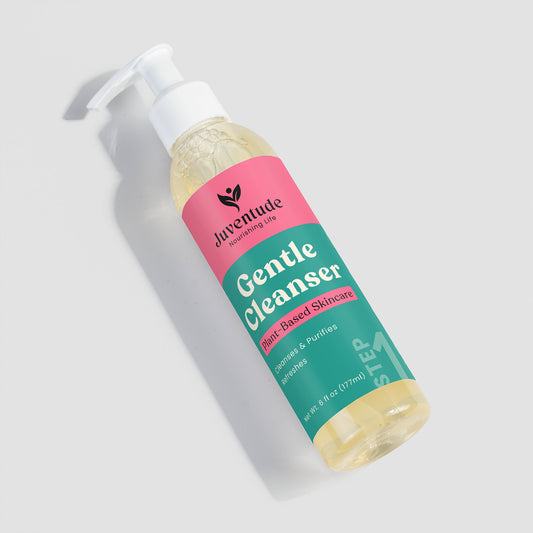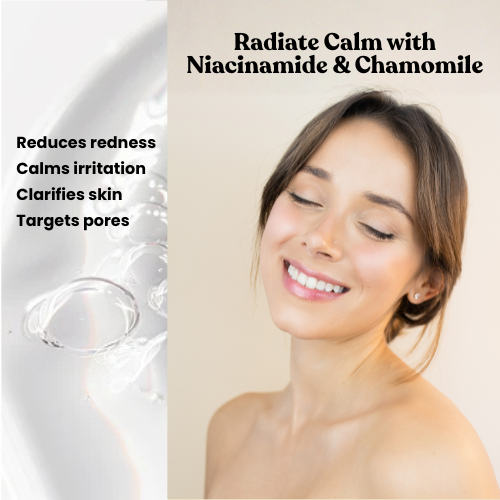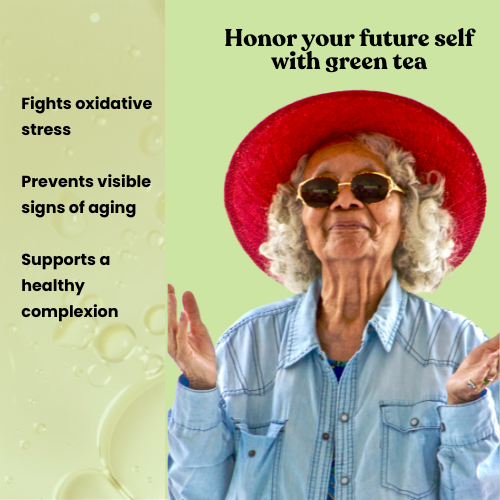-
Daily Nourishment Routine - Acne Prone Teens
Regular price $98.99 USDRegular price Sale price $98.99 USDUnit price per -
Gentle Cleanser
Regular price $24.99 USDRegular price Sale price $24.99 USDUnit price per -
Calming Radiance Serum
Regular price $23.99 USDRegular price Sale price $23.99 USDUnit price per -
Shine Control Toner
Regular price $31.00 USDRegular price Sale price $31.00 USDUnit price per -
Deep Hydration Serum
Regular price $34.99 USDRegular price Sale price $34.99 USDUnit price per -
Green Tea Shield Serum
Regular price $23.99 USDRegular price Sale price $23.99 USDUnit price per

Got spots?
Looking to tame blemishes and aren't sure where to start? Try the Calming Radiance Serum.
Ready for a comprehensive routine? Check out our curated routines for blemish-prone skin.
Clearer Days Ahead: Your Essential Guide to Managing Acne-Prone Skin
Acne-prone skin presents unique challenges. If you’re dealing with frequent breakouts, blackheads, or stubborn blemishes, you’re far from alone. Redness, irritation, and post-acne marks can make everyday skincare frustrating, but with the right approach, you can achieve a clearer, healthier complexion. The first step is understanding what triggers your acne and choosing products that calm, protect, and heal your skin—without causing further irritation. We're here to help you build a routine that targets breakouts, soothes sensitivities, and restores your confidence.
Indicators of Acne-Prone Skin
Recognizing acne-prone skin involves more than spotting the occasional pimple. Key signs include frequent blackheads, whiteheads, pustules, cysts, and inflamed or painful bumps—often concentrated on the face, back, chest, or shoulders. You may notice that your complexion is uneven, that blemishes linger or leave marks, and that your skin reacts easily to stress, new products, or hormonal changes. Being in tune with your skin’s responses helps in managing flare-ups and finding an effective, gentle routine.
Understanding Your Acne-Prone Skin
Acne-prone skin is typically driven by a combination of excess oil, clogged pores, bacteria, inflammation, and sometimes hormones. Genetics, stress, diet, and environmental factors also play a major role. While breakouts are frustrating, it’s important to remember that acne-prone skin still needs hydration and a healthy barrier to prevent irritation and promote healing. The main goal is to reduce breakouts, calm inflammation, and support your skin’s natural ability to recover.
The Skin Barrier: Your First Line of Defense
The skin barrier works to protect your face from pollution, bacteria, and environmental irritants. For acne-prone skin, keeping this barrier strong is essential: harsh products or over-exfoliating can disrupt the barrier, leaving your skin vulnerable to irritation and more breakouts. A steady routine featuring gentle, non-comedogenic products helps your skin stay resilient, minimize redness, and recover more quickly from blemishes.
Common triggers for breakouts and acne-prone skin include:
- Harsh Ingredients: Overuse of strong acids, scrubs, or alcohol-based products can strip the skin, worsen irritation, and trigger further breakouts.
- Comedogenic Products: Thick creams, heavy oils, or butters can block pores, leading to new blemishes.
- Environmental Stressors: Pollution, humidity, and sweat increase skin congestion and can worsen acne.
- Hormonal Fluctuations: Puberty, menstrual cycles, and stress can all trigger breakouts.
- Dietary Habits: High sugar, processed foods, and dairy may contribute to flare-ups in some people.
Why Cleansing is Essential for Acne-Prone Skin
Cleansing is at the core of any acne-prone skin routine. It removes excess oil, dirt, sweat, and impurities that can trigger breakouts or irritate active blemishes. Look for a gentle foaming or gel cleanser with acne-fighting ingredients like salicylic acid, and avoid overwashing—twice daily is enough. Harsh cleansers or scrubbing can dry out and irritate the skin, leading to more breakouts and a compromised barrier. Proper cleansing helps unclog pores, calm inflammation, and set the foundation for targeted treatments.
Why Should People with Acne-Prone Skin Use a Toner with Witch Hazel?
A toner with witch hazel is a smart addition for acne-prone skin. Witch hazel’s natural astringent qualities help tighten pores, reduce oil, and soothe inflamed skin. This ingredient is also known for its balancing and calming properties, helping reduce the look of redness and swelling that accompany breakouts. Using a witch hazel-based toner after cleansing ensures lingering impurities are removed while prepping your skin for optimal absorption of acne treatments and hydrators.
Why Use a Niacinamide Serum for Acne-Prone Skin
Niacinamide (vitamin B3) is a hero ingredient for acne-prone skin. It helps regulate oil production, strengthen the skin barrier, and minimize the appearance of pores—all while being gentle and non-irritating. Niacinamide’s anti-inflammatory qualities help fade redness, speed post-acne healing, and reduce the look of marks and scarring. Use a niacinamide serum after cleansing and toning to help even tone, calm blemishes, and reinforce your skin’s defenses.
Why Should People with Acne-Prone Skin Use a Green Tea Serum?
Green tea serum is well-suited for acne-prone skin thanks to its natural anti-inflammatory and antioxidant properties. Rich in polyphenols, green tea helps calm swelling, reduce redness, and prevent bacteria from worsening breakouts. Its gentle astringency can keep pores clear and control excess oil without causing dryness. Green tea also contributes to skin recovery by fighting free radicals and protecting against everyday environmental stressors that can trigger flare-ups. Applying this serum regularly can help soothe, protect, and clarify troubled skin.
Why Hydration Serums with Hyaluronic Acid Are Good for Acne-Prone Skin
Hydration is just as crucial for acne-prone skin as for any other type. Dehydration can increase oiliness and aggravate breakouts. Hydration serums with hyaluronic acid deliver lightweight, non-comedogenic moisture that won’t clog pores or feel greasy. Hyaluronic acid attracts and holds water in the skin, helping maintain a healthy, plump appearance. Proper hydration keeps your barrier strong, reduces excess oiliness, and allows your skin to heal more efficiently after breakouts.
These serums also help smooth uneven texture and minimize the appearance of scarring, resulting in skin that feels comfortable and looks more uniform. Their fast-absorbing, gentle nature makes them easy to layer under acne treatments and sunscreens.
Turmeric & Kojic Acid: Superstar Ingredients for Acne-Prone Skin
Turmeric and kojic acid are powerful additions to any acne-combatting skincare routine. Turmeric calms inflammation, reduces redness, and targets bacteria that can worsen breakouts, while its antioxidant action helps skin heal from acne-related damage. Kojic acid shines when it comes to fading dark spots, discoloration, and marks left after blemishes have healed. Together, they work to even out tone, reduce lingering signs of breakouts, and keep skin bright—without risking congestion or irritation.
Practical Tips to Manage and Balance Acne-Prone Skin
Building healthy habits is key to controlling and preventing breakouts. Use these tips to help clear, soothe, and support your acne-prone skin:
1. Hands Off!
- Avoid touching your face throughout the day to prevent spreading bacteria and worsening breakouts.
2. Change Pillowcases and Towels Often
- Clean, soft fabrics help reduce bacteria and oil transfer that could contribute to acne.
3. Hydrate—and Don’t Skip Moisturizer
- Drink water and apply a gentle hydrating serum or moisturizer daily; even acne-prone skin needs moisture to heal and rebalance.
4. Don’t Overwash or Over-Exfoliate
- Cleansing more than twice a day or using harsh scrubs can irritate acne and delay healing. Use gentle products and avoid physical scrubbing.
5. Look for Non-Comedogenic, Oil-Free Products
- From cleansers to makeup, choose items labeled non-comedogenic and oil-free to avoid clogging pores.
6. Patch Test Everything
- Always patch test new products to check for reactions before applying them to your face.
7. Keep Hair Clean and Away from Your Face
- Oils, styling products, and dirt from hair can transfer to your skin and cause breakouts.
8. Shower After Sweating
- After workouts or being in hot, humid environments, shower promptly to remove sweat and bacteria.
9. Eat a Skin-Friendly Diet
- Focus on fruits, vegetables, and omega-3-rich foods, while limiting processed foods, dairy, and sugar, which may trigger some people’s breakouts.
10. Be Mindful of Sun Exposure
- While some sun can reduce inflammation, too much can irritate and worsen acne. Always use a broad-spectrum, non-comedogenic sunscreen.
11. Manage Stress
- Stress impacts hormones and can intensify breakouts. Try mindfulness, exercise, or relaxation techniques to stay balanced.
12. Treat Gently—Don’t Pick or Squeeze
- Popping pimples can spread bacteria, cause scarring, and prolong healing. Treat flaws with care and patience.
These DIY tips can help you keep acne-prone skin clearer, calmer, and healthier over time.
Know the Ingredients
For acne-prone skin, understanding ingredients is key. Choose products that unclog pores and calm irritation without adding to congestion or redness.
Ingredients to Avoid:
- Heavy Oils and Butters: Like coconut oil, cocoa butter, and lanolin, which can block pores.
- Alcohol-Heavy Formulas: Over-drying alcohols can irritate and worsen blemishes.
- Thick Emollients: Petrolatum and mineral oil should be avoided.
- Synthetic Fragrances: Perfumes may cause further inflammation or trigger breakouts.
Care for Your Acne-Prone Skin
Ready to care for your skin with gentle, proven solutions? Discover options designed to reduce breakouts, soothe irritation, and help you achieve the clearer, confident complexion you deserve.












